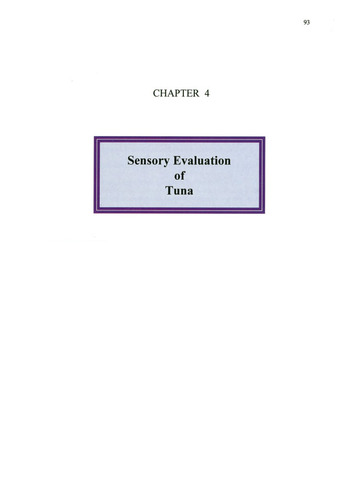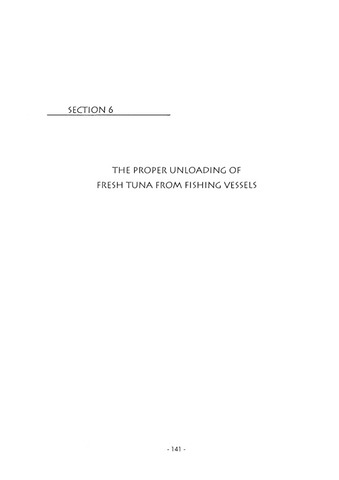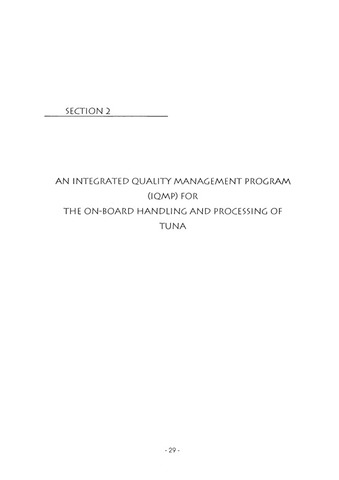08 SEAFDEC/MFRD Publications: Recent submissions
Now showing items 101-120 of 325
-
Sensory evaluation of tuna
(Marine Fisheries Research Department, Southeast Asian Fisheries Development Center, 1995) -
Inspection/verification of a tuna cannery
(Marine Fisheries Research Department, Southeast Asian Fisheries Development Center, 1995) -
HACCP plan for canned tuna
(Marine Fisheries Research Department, Southeast Asian Fisheries Development Center, 1995) -
Good manufacturing practices for the canning of tuna
(Marine Fisheries Research Department, Southeast Asian Fisheries Development Center, 1995) -
The proper unloading of fresh tuna from fishing vessels
(Marine Fisheries Research Department, Southeast Asian Fisheries Development Center, 1997) -
Improved quality control for the handling and processing of fresh and frozen tuna at sea and on shore
(Marine Fisheries Research Department, Southeast Asian Fisheries Development Center, 1997) -
An integrated quality management program (IQMP) for the on-shore handling and processing of fresh and frozen tuna
(Marine Fisheries Research Department, Southeast Asian Fisheries Development Center, 1997) -
An integrated quality management program (IQMP) for the on-board handling and processing of tuna
(Marine Fisheries Research Department, Southeast Asian Fisheries Development Center, 1997) -
Good manufacturing practices for the on-shore handling and processing of tuna
(Marine Fisheries Research Department, Southeast Asian Fisheries Development Center, 1997) -
Grading of bigeye and yellowfin tuna
(Marine Fisheries Research Department, Southeast Asian Fisheries Development Center, 1997) -
Good manufacturing practices for the on-board handling and processing of tuna
(Marine Fisheries Research Department, Southeast Asian Fisheries Development Center, 1997) -
Laboratory manual on analytical methods and procedures for fish and fish products
(Marine Fisheries Research Department, Southeast Asian Fisheries Development Center, 1987)The manual provides useful guides for laboratory workers and technical personnel. The procedures for determining the physical and chemical properties of fish meat, the analysis of oils and some additives and microbiological ... -
Microbial procedure: Vibrio parahaemolyticus
(Marine Fisheries Research Department, Southeast Asian Fisheries Development Center, 1987)Food poisoning due to Vibrio parahaemolyticus is afood-borne infection resulting from the ingestion of alarge number of this organism (about 106-109 viable cells). The major symptoms are diarrhea and abdominal pain with ... -
Microbial procedure: Vibrio cholera
(Marine Fisheries Research Department, Southeast Asian Fisheries Development Center, 1987)Cholera is an acute specific infection caused by the organism, Vibrio cholera. Diagnosis may be confirmed by the presence of large numbers of the comma-shaped bacilli on direct microscopic examination of a fecal or vomitus ... -
Microbial procedure: Faecal streptococci
(Marine Fisheries Research Department, Southeast Asian Fisheries Development Center, 1987)Streptococci are gram-positive cocci, sometimes coccobacilli, arranged in chains. This group of streptococci resides in the intestine of warm-blooded animals. They are bile resistant and capable of growth at 45°C. Fecal ... -
Microbial procedure: Staphylococcus aureus
(Marine Fisheries Research Department, Southeast Asian Fisheries Development Center, 1987)Staphylococcus aureus is a common organism on the skin and in the nasal passages of approximately 50% of the population. Heat-treated seafood may become contaminated with this organism by poor handling, then storage at ... -
Microbial procedure: Salmonellae & Shigella
(Marine Fisheries Research Department, Southeast Asian Fisheries Development Center, 1987)Salmonella is a gram-negative bacterium of the family Enterobacteriaceae. Salmonella lives in animal and human intestines and is shed through feces, which usually infects humans through contaminated water or food. The paper ... -
Microbial procedure: Coliforms and Escherichia coli
(Marine Fisheries Research Department, Southeast Asian Fisheries Development Center, 1987)Coliforms are Gram-negative, non-sporing, facultatively anaerobic rods which ferment lactose, producing acid and gas within 48 hrs and they belong to the family Enterobacteriaceae. Presented in the paper is the methodology ... -
Microbial procedure: Aerobic plate count
(Marine Fisheries Research Department, Southeast Asian Fisheries Development Center, 1987)The aerobic plate count provides an estimate of the number of viable microorganisms in the food according to the medium used and the time and temperature incubation. Presented in the paper is the aerobic plate count procedure ... -
Microbial procedure: Handling of food samples
(Marine Fisheries Research Department, Southeast Asian Fisheries Development Center, 1987)Proper handling of samples is presented in the paper. Specifically, the procedures in the proper collection, transport, and storage of samples are presented. Moreover, the procedures of monitoring of the condition of samples ...




















